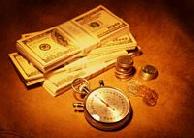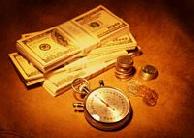
 |
|
| Financial Terms | |
| break-even chart |
|
Information about financial, finance, business, accounting, payroll, inventory, investment, money, inventory control, stock trading, financial advisor, tax advisor, credit.
Main Page: inventory control, financial advisor, financial, money, accounting, finance, tax advisor, stock trading, |
Definition of break-even chart
break-even charta graph that depicts the relationships among revenues, variable costs, fixed costs, and profits (or losses)
Related Terms:BreakA rapid and sharp price decline. Break-even analysisAn analysis of the level of sales at which a project would make zero profit. Break-even lease paymentThe lease payment at which a party to a prospective lease is indifferent between Break-even payment rateThe prepayment rate of a MBS coupon that will produce the same CFY as that of Break-even tax rateThe tax rate at which a party to a prospective transaction is indifferent between entering Break-even timeRelated: Premium payback period. BreakoutA rise in a security's price above a resistance level (commonly its previous high price) or drop  Cash-flow break-even pointThe point below which the firm will need either to obtain additional financing ChartistsRelated: technical analysts. Corporate charterA legal document creating a corporation. Evening upBuying or selling to offset an existing market position. Event riskThe risk that the ability of an issuer to make interest and principal payments will change because Event studyA statistical study that examines how the release of information affects prices at a particular time. Events of defaultContractually specified events that allow lenders to demand immediate repayment of a debt. Group of seven (G7/G-7)The G-5 countries plus Canada and Italy. Industrial revenue bond (IRB)Bond issued by local government agencies on behalf of corporations.  Point and figure chartA price-only chart that takes into account only whole integer changes in price, i.e., a Revenue bondA bond issued by a municipality to finance either a project or an enterprise where the issuer Revenue fundA fund accounting for all revenues from an enterprise financed by a municipal revenue bond. Total revenueTotal sales and other revenue for the period shown. Known as "turnover" in the UK. NET SALES (revenue)The amount sold after customers’ returns, sales discounts, and other allowances are taken away from Breakeven pointThe point at which total costs equal total revenue, i.e. where there is neither a profit nor a loss. RevenueIncome earned from the sale of goods and services. RevenueAmounts earned by the company from the sale of merchandise or services; often used interchangeably with the term sales. Unearned revenueMoney that has been paid by customers for work yet to be done or goods yet to be provided. breakeven pointThe annual sales volume level at which total contribution revenue-driven expensesOperating expenses that vary in proportion to  break-even point (BEP)the level of activity, in units or dollars, at which total revenues equal total costs control charta graphical presentation of the results of a incremental revenuethe revenue resulting from an additional contemplated sale organization charta depiction of the functions, divisions, prevention costa cost incurred to improve quality by preventing revenue centera responsibility center for which a manager is accountable only for the generation of revenues and has no control over setting selling prices, or budgeting or incurring costs value charta visual representation indicating the valueadded Bollinger band chartA financial chart that plots actual asset data along Candlestick chartA financial chart usually used to plot the high, low, open, High-low-close chartA financial chart usually used to plot the high, low, Moving-averages chartA financial chart that plots leading and lagging Point and figure chartA financial chart usually used to plot asset price data. Breakeven pointThe sales level at which a company, division, or product line makes a Chart of accountsA listing of all accounts used in the general ledger, usually sorted in RevenueAn inflow of cash, accounts receivable, or barter from a customer in exchange Unearned revenueA payment from a customer that cannot yet be recognized as earned break-even analysisAnalysis of the level of sales at which the company breaks even. Internal Revenue CodeRefers to all federal tax laws as a group. Internal Revenue ServiceA federal agency empowered by Congress to interpret and enforce tax-related laws. Fictitious RevenueRevenue recognized on a nonexistent sale or service transaction. Premature RevenueRevenue recognized for a confirmed sale or service transaction in a period Realizable Revenue A revenue transaction where assets received in exchange for goods andservices are readily convertible into known amounts of cash or claims to cash. Realized RevenueA revenue transaction where goods and services are exchanged for cash or Revenue RecognitionThe act of recording revenue in the financial statements. Revenue should Sales Revenue Revenue recognized from the sales of products as opposed to the provision ofservices. Service RevenueRevenue recognized from the provision of services as opposed to the sale of Break-EvenThis is a term used to describe a point at which revenues equal costs. Break-Even AnalysisAn analytical technique for studying the relationships between fixed cost, variable cost, and profits. A breakeven chart graphically depicts the nature of breakeven analysis. The breakeven point represents the volume of sales at which total costs equal total revenues (that is, profits equal zero). Deal BreakerA deal breaker is a significant issue relating to the proposed financing between the prospective investor and the entrepreneur that needs to be resolved in order to close the deal. Related to : financial, finance, business, accounting, payroll, inventory, investment, money, inventory control, stock trading, financial advisor, tax advisor, credit. |